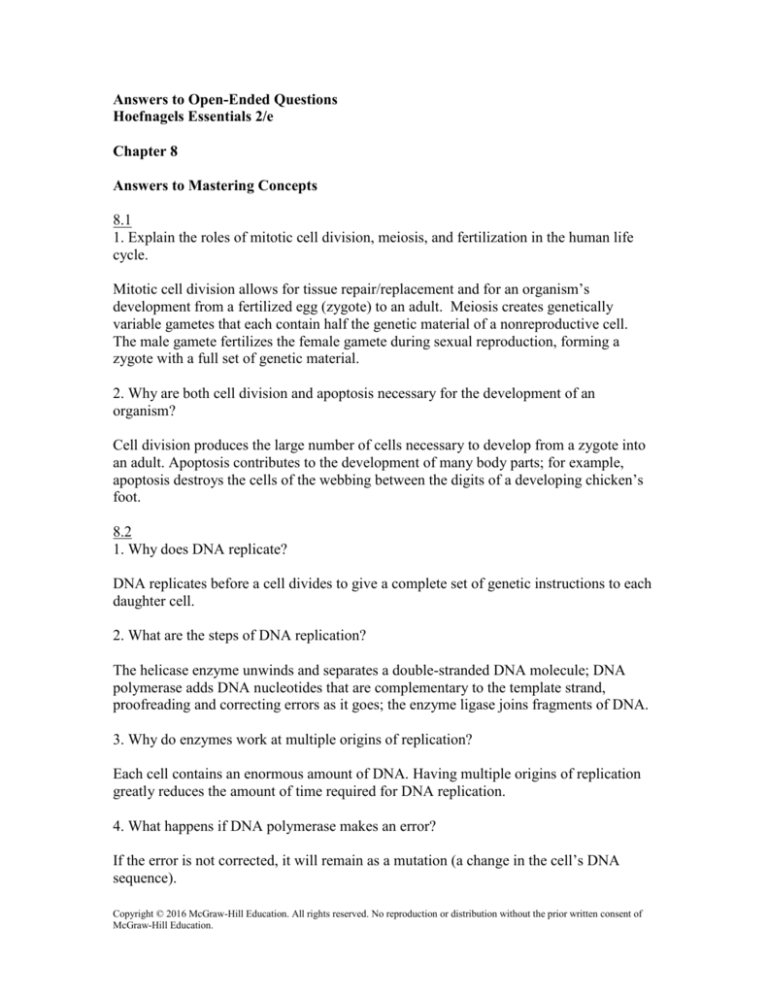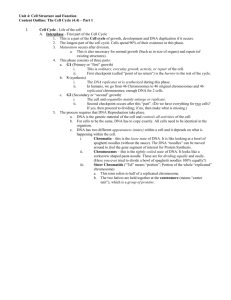
Answers to Open-Ended Questions
Hoefnagels Essentials 2/e
Chapter 8
Answers to Mastering Concepts
8.1
1. Explain the roles of mitotic cell division, meiosis, and fertilization in the human life
cycle.
Mitotic cell division allows for tissue repair/replacement and for an organism’s
development from a fertilized egg (zygote) to an adult. Meiosis creates genetically
variable gametes that each contain half the genetic material of a nonreproductive cell.
The male gamete fertilizes the female gamete during sexual reproduction, forming a
zygote with a full set of genetic material.
2. Why are both cell division and apoptosis necessary for the development of an
organism?
Cell division produces the large number of cells necessary to develop from a zygote into
an adult. Apoptosis contributes to the development of many body parts; for example,
apoptosis destroys the cells of the webbing between the digits of a developing chicken’s
foot.
8.2
1. Why does DNA replicate?
DNA replicates before a cell divides to give a complete set of genetic instructions to each
daughter cell.
2. What are the steps of DNA replication?
The helicase enzyme unwinds and separates a double-stranded DNA molecule; DNA
polymerase adds DNA nucleotides that are complementary to the template strand,
proofreading and correcting errors as it goes; the enzyme ligase joins fragments of DNA.
3. Why do enzymes work at multiple origins of replication?
Each cell contains an enormous amount of DNA. Having multiple origins of replication
greatly reduces the amount of time required for DNA replication.
4. What happens if DNA polymerase makes an error?
If the error is not corrected, it will remain as a mutation (a change in the cell’s DNA
sequence).
Copyright © 2016 McGraw-Hill Education. All rights reserved. No reproduction or distribution without the prior written consent of
McGraw-Hill Education.
8.3
1. What are the events of binary fission?
The cell’s DNA replicates, and the two chromosomes attach to the cell membrane. The
cell grows between the two attachment points, pulling the two chromosomes apart. The
cell wall and cell membrane then pinch inward, dividing the cell into two identical
daughter cells.
2. What are the sources of genetic variation in bacteria and archaea?
Mutation is the main source of genetic variation in bacteria and archaea. However, they
can also receive new genes from living cells or absorb DNA released from dead cells.
8.4
1. What is the relationship between DNA, histones, and chromatin?
Chromatin is organized into nucleosomes, which are stretches of DNA wrapped around
clusters of eight proteins called histones.
2. Sketch and label the main parts of a duplicated chromosome.
The main parts include two identical sister chromatids and the centromere where they are
attached. Your drawing should look like the lower part of figure 8.9.
8.5
1. What are the three main events of the cell cycle?
The three main events of the cell cycle are interphase, mitosis, and cytokinesis.
2. What happens during interphase?
During interphase, the cell grows and produces proteins needed to carry out its functions.
In addition, DNA replicates as the cell prepares to divide.
3. Suppose a centromere does not split during anaphase; describe the chromosomes in the
daughter cells.
If a centromere failed to split during anaphase, one daughter cell would have an extra
chromosome, and the other daughter cell would be missing one chromosome.
4. What happens during each stage of mitosis?
In early prophase, chromosomes condense and become visible; the mitotic spindle also
forms. In late prophase, the nuclear envelope breaks up, and spindle fibers attach to the
Copyright © 2016 McGraw-Hill Education. All rights reserved. No reproduction or distribution without the prior written consent of
McGraw-Hill Education.
chromosomes. In metaphase, the chromosomes line up at the equator of the cell. In
anaphase, the centromeres split, and sister chromatids separate and move to opposite
poles of the cell. In telophase, the nuclear membrane and nucleolus form at each pole, the
chromosomes decondense, and the spindle disappears.
5. Distinguish between mitosis and cytokinesis.
Mitosis is the division of duplicated chromosomes into two daughter nuclei. Cytokinesis
is the division of cytoplasm and organelles (including the two nuclei) into two daughter
cells.
8.6
1. What prevents normal cells from dividing when they are not supposed to?
Signaling proteins ensure that cells do not divide at improper times.
2. List and describe the three most common cancer treatments.
Surgical tumor removal removes the cancerous mass and (often) nearby tissue.
Chemotherapy drugs circulate throughout the body and stop cancer cells from dividing.
Radiation uses targeted streams of radiation to kill tumor cells. Chemotherapy and
radiation treatments are both “blunt” tools that target any rapidly dividing cell types,
though radiation treatment is much more localized.
3. What is the relationship between genetic mutations and cancer?
DNA encodes each of the many proteins that regulate the cell cycle and apoptosis.
Mutations in these genes can cause the signaling proteins to be abnormal, cause
malfunctions in the cell’s response to the signaling proteins, or cause apoptosis to fail.
Any of these changes can result in cells that divide out of control.
Answers to Write It Out Questions
1. Explain how cell division and cell death work together to form a functional
multicellular organism.
Cell division produces new cells and is therefore necessary for growth. Cell death
removes certain cells, as needed for the development of specialized structures.
2. Use words and diagrams to describe how DNA is copied in a cell.
The helicase enzyme unwinds and separates the two strands of a DNA molecule; DNA
polymerase adds DNA nucleotides that are complementary to the template strand,
proofreading and correcting errors as it goes; the ligase enzyme joins fragments of DNA.
Your diagram should be similar to figure 8.4.
Copyright © 2016 McGraw-Hill Education. All rights reserved. No reproduction or distribution without the prior written consent of
McGraw-Hill Education.
3. If a cell contains all the genetic material it needs to synthesize protein, why must the
DNA also replicate?
The DNA must replicate prior to cell division so that each daughter cell receives the same
genetic instructions.
4. Sketch and describe the events that occur when a bacterial cell divides.
The cell’s DNA replicates, and the two chromosomes attach to the cell membrane. The
cell grows between the two attachment points, pulling the two chromosomes apart. The
cell wall and cell membrane then pinch inward, dividing the cell into two identical
daughter cells. Your sketch should be similar to figure 8.6.
5. List the ways that binary fission is similar to and different from mitosis.
Both binary fission and mitotic cell division are asexual, meaning they produce identical
daughter cells. Both are preceded by DNA replication. However, binary fission and
mitotic cell division take place in different cell types (prokaryotic cells undergo binary
fission, whereas eukaryotic cells divide mitotically). Binary fission does not require that
chromosomes condense; mitosis does. Binary fission does not require a spindle; in
mitotic cell division, a spindle moves the chromosomes within the cell.
6. Obtain a rubber band and twist it as many times as you can. What happens to the
overall shape of the rubber band? How is this similar to what happens to chromosomes as
a cell prepares to divide? How is it different?
The more you twist the rubber band the more it wraps on itself, with coils forming
supercoils. The more you twist, the more compact the rubber band. Similarly, chromatin
forms coils and supercoils to become a tightly compacted visible chromosome. Unlike a
rubber band, however, chromatin wraps around scaffold proteins to help direct its
compaction.
7. Label the arrows connecting the chromosome images in figure 8.14 with the phase of
the cell cycle in which each event occurs.
The arrow labeled “DNA replicates” corresponds to S phase of interphase. The arrow
labeled “DNA condenses” corresponds to early prophase. The arrow labeled “Centromere
splits” corresponds to anaphase.
8. Which contains the most DNA, a cell in G1 or a cell in G2 phase?
A cell in G2 contains more DNA than a cell in G1. DNA replicates during S phase, which
occurs between G1 and G2.
Copyright © 2016 McGraw-Hill Education. All rights reserved. No reproduction or distribution without the prior written consent of
McGraw-Hill Education.
9. If you draw on your skin with a permanent marker, the markings will fade in a couple
of days. What does this simple demonstration reveal about cell division in your skin?
What can you infer about tattoos?
The cells on the skin’s surface are rapidly being replaced with new cells. The old cells
fall off, taking a fragment of the markings with them. Tattoos are permanent because the
ink resides in a lower layer of skin called the dermis, not directly on the skin’s surface.
10. Why do chemotherapy and radiation sometimes kill hair follicle cells along with
cancer, while leaving many other cells unaffected?
Chemotherapy and radiation target rapidly dividing cells. Cancer cells divide rapidly, as
do hair follicle cells, so chemotherapy and radiation kill both of these cell types. In most
body cells, however, the rate of cell division is not fast enough to be affected by
chemotherapy or radiation.
11. A protein called p53 promotes the expression of genes encoding DNA repair
enzymes. Badly damaged DNA prompts p53 to trigger apoptosis, and the cell dies. Why
might mutations in the gene encoding p53 be associated with a high risk for cancer?
A mutated p53 gene might encode a nonfunctional p53 protein. DNA repair enzymes
would therefore be in low concentration and the cell might continue dividing with
damaged DNA. Cancer occurs when cells divide out of control.
Answers to Pull It Together Questions
1. Add DNA polymerase, nucleotides, and complementary base pairing to this concept
map.
“DNA replication” connects with the phrase “requires the addition of new” to
“Nucleotides,” which connects with the phrase “are added by” to “DNA polymerase.”
“DNA polymerase” connects with the phrase “adds nucleotides based on” to
“Complementary base pairing.”
2. Add cell growth and tissue repair to the concept map.
“Cell growth” connects with the phrase “occurs during” to “Interphase.” “Mitotic cell
division” connects with the phrase “produces cells required for” to “Tissue repair.”
3. What is the relationship between mitotic cell division and apoptosis?
Mitotic cell division creates new cells; apoptosis (programmed cell death) removes
unneeded or damaged cells.
Copyright © 2016 McGraw-Hill Education. All rights reserved. No reproduction or distribution without the prior written consent of
McGraw-Hill Education.









